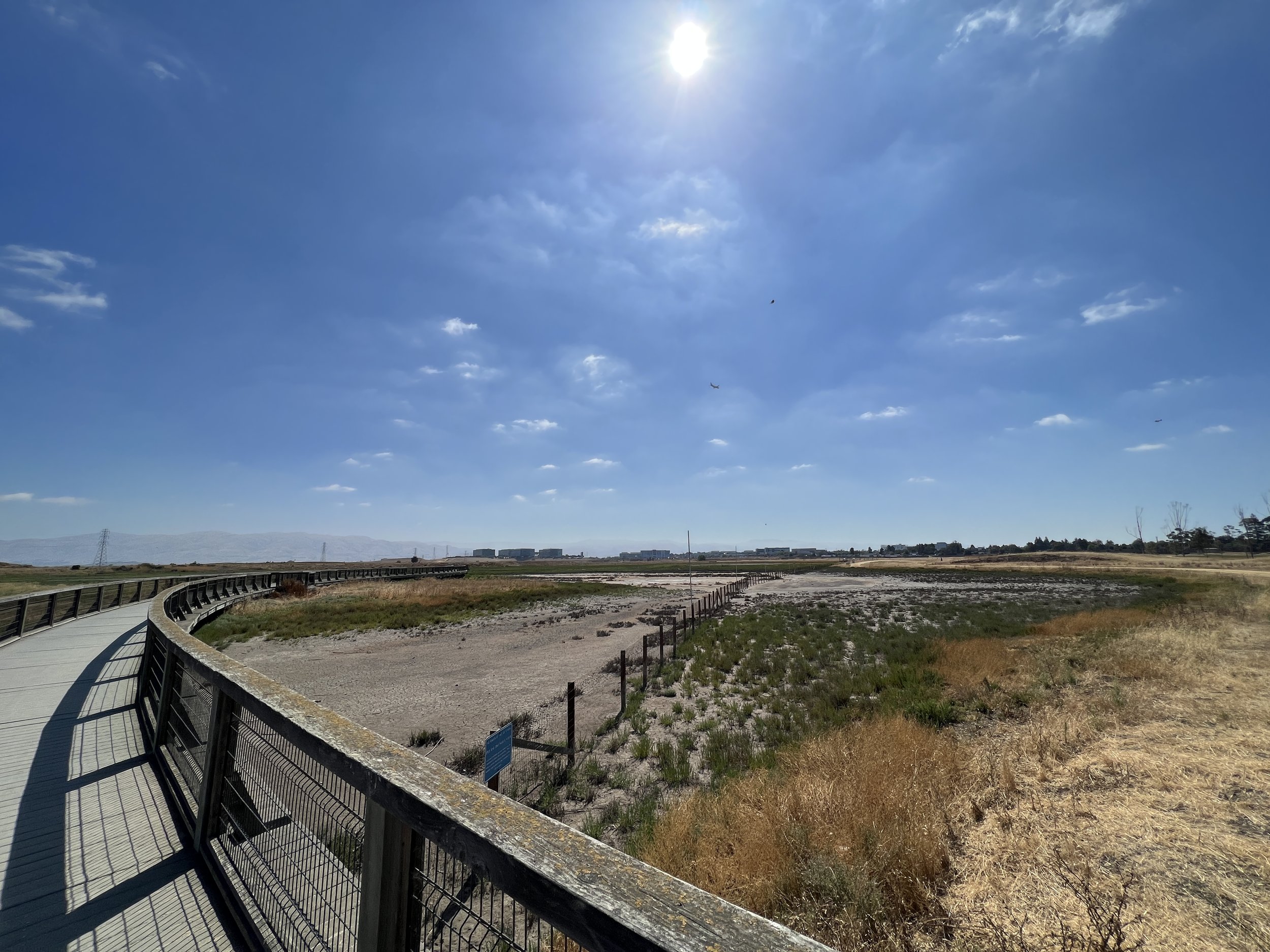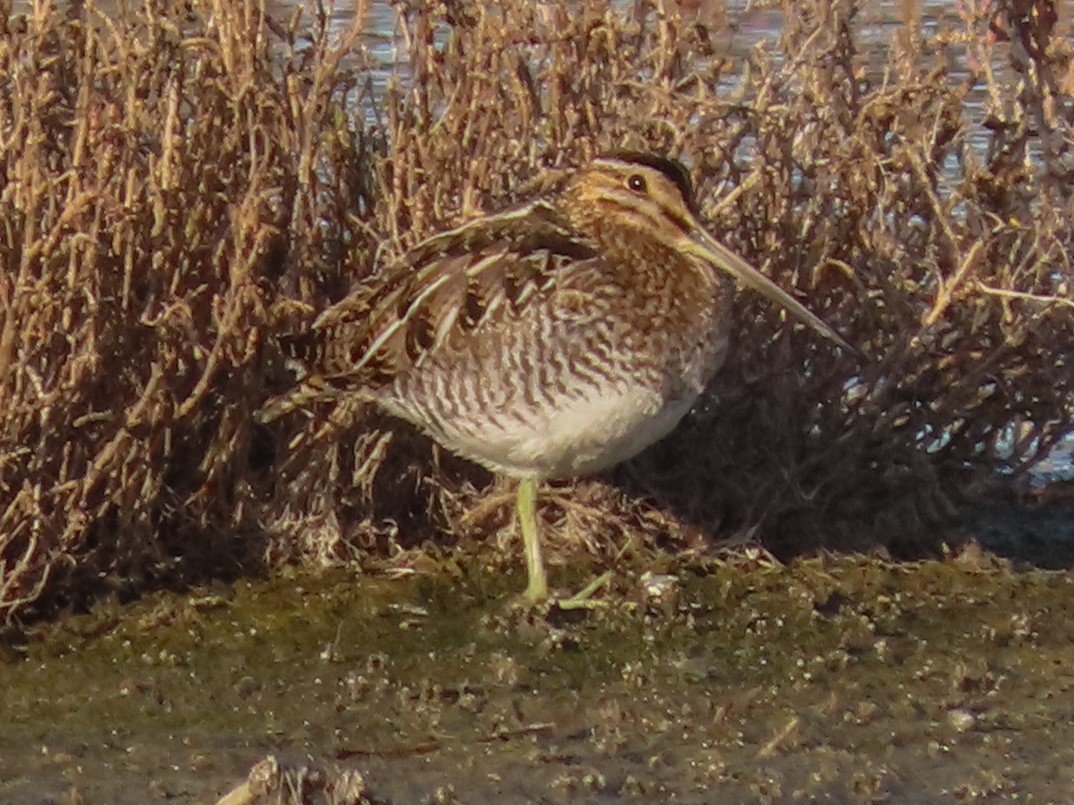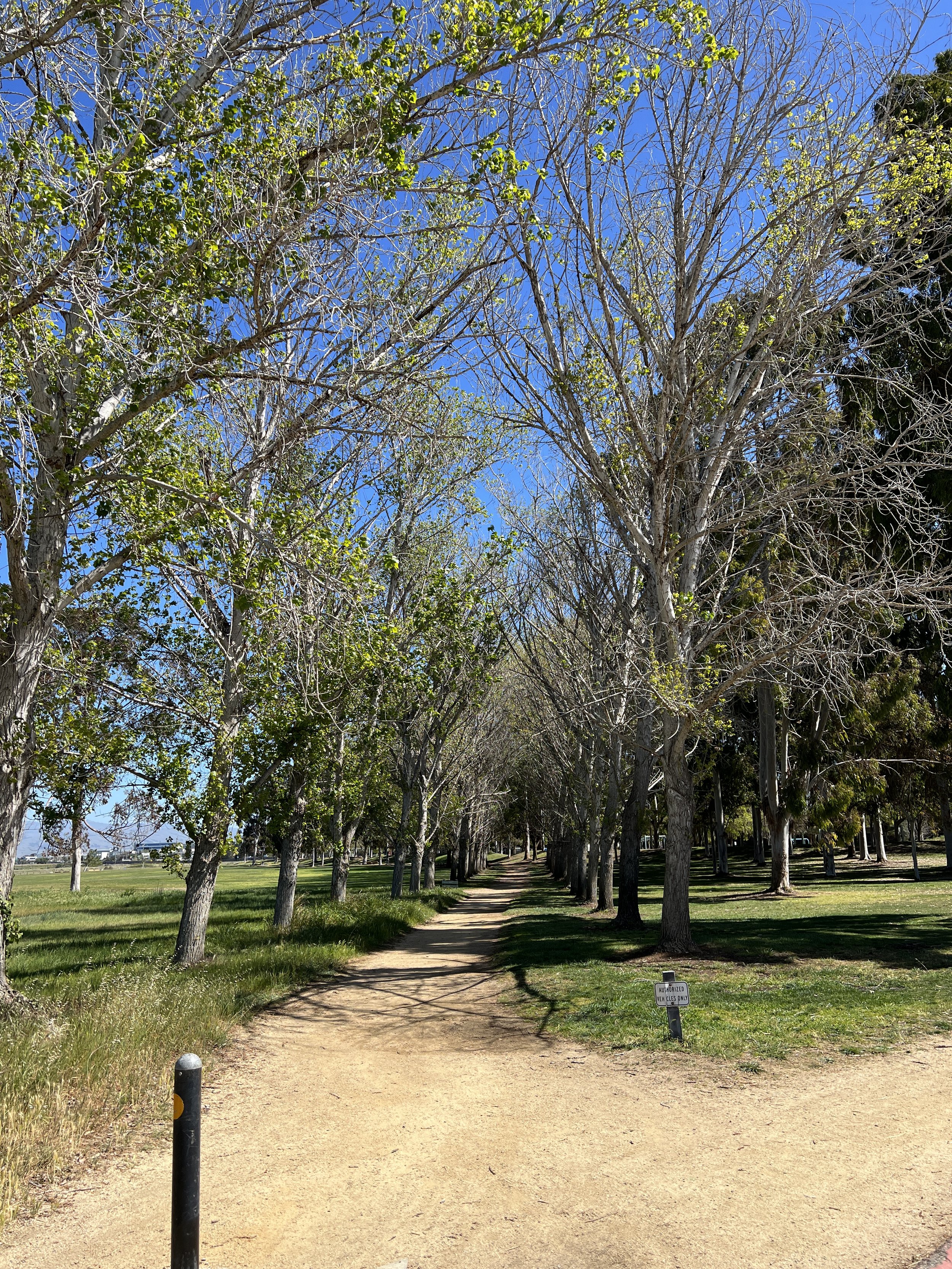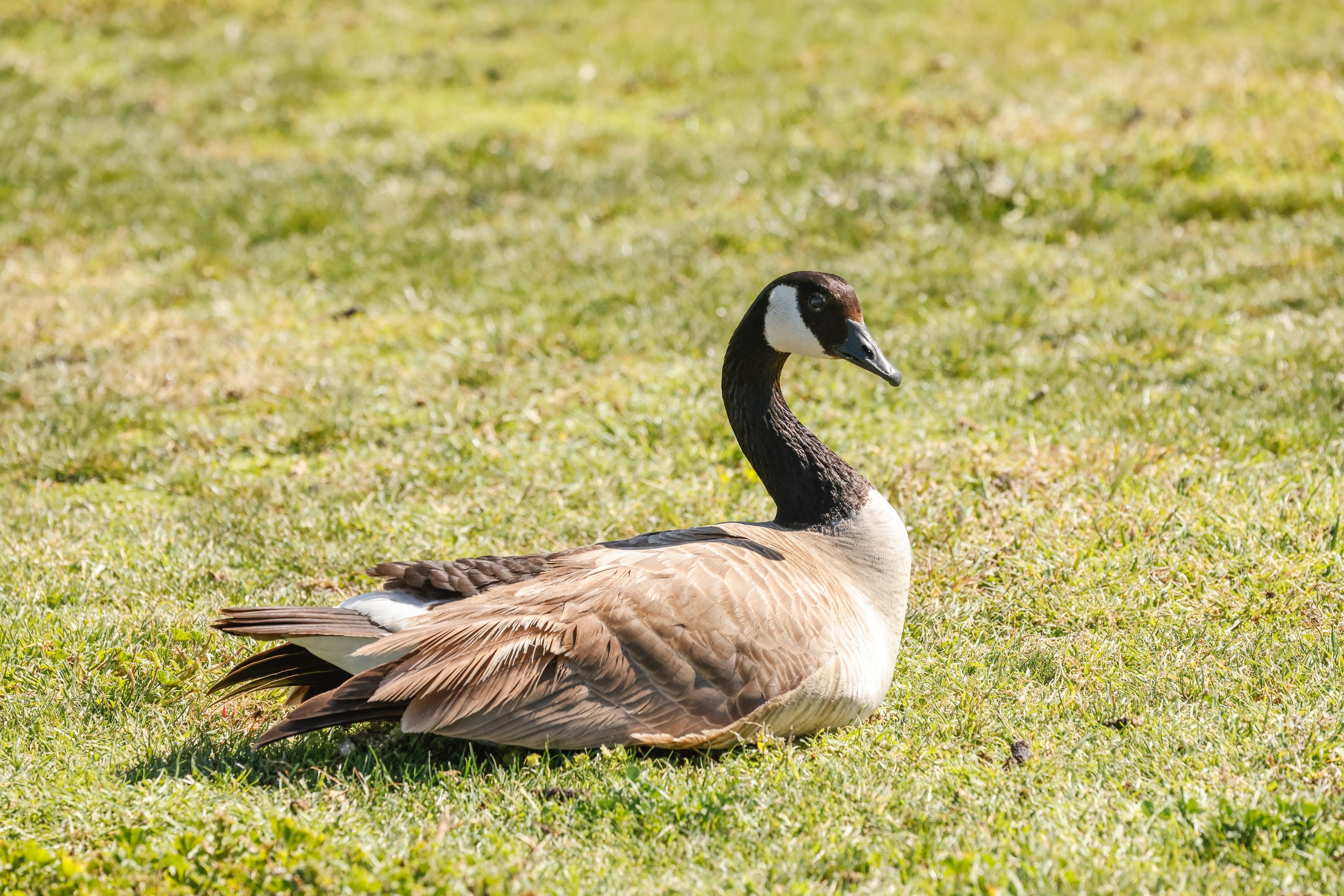Sunnyvale Baylands (Year-round):
Reclaimed Habitat
by Barry Langdon-Lassagne
Whether searching for waterfowl and shorebirds in winter or upland birds in spring through fall, the reclaimed water from the nearby Sunnyvale Water Pollution Control Plant make the Sunnyvale Baylands park a haven for birds and human visitors any time of year. Over a hundred acres of restored seasonal wetlands adjacent to the park provide a variety of habitats for many bird species. In the winter, water levels in the wetlands are high and attractive to ducks and geese, while in the summer, lawns and trees in the cooler south and central portions of the park offer shade and excellent habitat for Pacific-slope Flycatcher, Hooded Oriole, American Robin, Western Bluebird and Dark-eyed Junco.
Trip Covers: Year-round
Key Birds (spring/summer/fall): Nuttall’s Woodpecker, Pacific-slope Flycatcher, Hooded Oriole, Bullock’s Oriole, Western Tanager. Winter: Canada Goose, Ross’ Goose, White-fronted Goose, Cackling Goose, Snow Goose, Cinnamon Teal, American Wigeon, Wilson’s Snipe.
How to Bird
About Sunnyvale Baylands Park
Created in 1991 as a joint project between Santa Clara County and the City of Sunnyvale, the park is part restored wetland and part city park, with a variety of habitats including savanna-like woodlands, grasslands, lush lawn and wooded areas, and a large restored wetland that contains both freshwater and brackish or saltwater.
The boardwalk in winter
The boardwalk in summer
Birding
Red-tailed Hawk (juvenile). Redtails are here year-round
A hike at Sunnyvale Baylands typically starts at one of the parking areas at either the northwest or southeast end of the park. Looping the edges of the park covers the most habitats and offers the most views of the wetlands. If you’re arriving on foot, you can start at the entrance and follow the same loop.
Let's start in the parking lot at the northwest corner of the park and take the trail east toward the boardwalk. Our entire walk will be about one mile, all on level paths. Before embarking on the trail, scan the trees around the edges of the parking lot. You can often find flycatchers, goldfinches and warblers in the spring and fall.
As you start on the hiking trail, notice that this part of the park (#1 on the interactive map) is grassy with a few oak trees, similar to oak savanna habitats like we have in other parts of the county. Check the trees for Nuttall’s Woodpecker (small, with white speckles all over its black back), Chestnut-backed Chickadee, Oak Titmouse (both of these tiny birds make frequent “chick-a-dee-dee” calls) and Lesser Goldfinch (a small yellow bird, often found in groups near the treetops). Off to the north is a large sports complex in whose light towers raptors such as Red-tailed Hawk can be spotted roosting or even nesting. All of these birds can be found here year-round.
After wandering the northern reaches of the park, you’ll arrive at a wooden boardwalk that heads out over the brackish (somewhat salty) wetlands (#2 on the map). In winter, check the fences for Say's Phoebe, which appears similar to our familiar Black Phoebe (who is here year-round) but with brown feathers instead of black and white. Along the boardwalk check for Song Sparrow, who may perch on the railing and sing vociferously and Savannah Sparrow, who will generally skulk down in the pickleweed and brush below the boardwalk. These two similar streaky sparrows are found any time of year throughout the wetlands along the bay.
At the end of the boardwalk, scan the waters, skies and surrounding grasslands. Canada Goose, Cinnamon Teal, Gadwall, American Wigeon, Bufflehead, Ruddy Duck and other interesting ducks and geese frequent the ponds in winter. As the wetlands dry out in the spring, there may be more shorebirds and fewer waterfowl. Look for Greater Yellowlegs, Willet, and maybe a Spotted Sandpiper feeding along the muddy edges of the water. In the skies above, Red-tailed Hawk, White-tailed Kite, Turkey Vulture, Peregrine Falcon and other birds of prey can be found any time of year. Anywhere in the fields or wetlands, you may find Great Blue Heron, Great Egret or Snowy Egret hunting year-round.
Heading back to the gravel trail, you’ll see a small pond directly in front of you (#3 on the map). In winter, Wilson's Snipe will sometimes hide along the edge of this small pond if there's water in it. They are often invisible until flushed when they burst out of the low plant cover and hastily fly away. These birds are about the size of a baseball, with bulging eyes and brown and black patterning on their bodies and they're very shy.
Wilson’s Snipe in the small pond southwest of the boardwalk. Photo by Ginger Langdon-Lassagne
From here take the gravel trail southeast, following the fence line which separates the park's public areas to the right from the wetlands on your left. As you walk you’ll come to a viewing platform on your left overlooking year-round freshwater ponds (#4). The water for this marsh comes from the Sunnyvale Water Pollution Control Plant just down Caribbean Drive. The lawns and trees of Sunnyvale Baylands are also kept green by this reclaimed wastewater. Check the ponds for more ducks, geese, and shorebirds. In winter, White-crowned Sparrow and Golden-crowned Sparrow can be found feeding on the ground or sitting on a fence. As you continue southeast, you’ll come to a large lawn on your right that is often used by people flying drones, model planes, or kites. If it's not crowded with people, it may be crowded with Canada Geese—check among the flock for the rarer Cackling Goose, Greater White-fronted Goose, Snow Goose or Ross' Goose in the winter. These geese may also be out in the wide grasslands to your left. Mornings, before the geese have flown, are the best time for viewing. Late afternoons when they come back in for the night can also be good, but the winds can get high later in the day, making viewing less pleasant.
White-crowned Sparrow on the fence between the park and the wetlands (fall through spring)
Western Bluebird in the picnic areas (spring through fall)
Anna’s Hummingbird near the wetlands (year-round)
As you approach the end of the dirt path at the southeast corner of the park, you'll see a road running east parallel to the freeway. This road can take you to a loop around Harvey Marsh or connect you to the Bay Trail, San Tomas Aquino Creek Trail or the town of Alviso, but today we'll hang a right and keep near the lawn to look for orioles and flycatchers in the trees along the picnic areas. The restroom at this corner is closed, but there's an open one as you head west (see the interactive map). Near the open restroom is where the Vermillion Flycatcher has been seen in spring, but even without such a rarity you can often find Pacific-slope Flycatcher, whose "hail-a-taxi" whistle can lead you to glimpse this small bird perched on a branch from which it flies and returns in its hunt for insects. Even in a summer drought, this area is lush due to the plentiful reclaimed water, and that means lots of birds gather here. You should see Anna’s Hummingbird, Nuttall’s Woodpecker, Northern Flicker, Western Bluebird, American Robin, and Dark-eyed Junco. Listen for the chattering and "veenk!" call of the bright orange and black Hooded Oriole calling from a eucalyptus or the top of an ash tree. You may occasionally find a Western Wood-Pewee or Ash-throated Flycatcher in spring here as well.
Cottonwoods flanking the Meadow Trail
Just before the road curves north, you may want to cut across the picnic areas and explore the parallel rows of cottonwoods bordering what is called the "Meadow Trail" (#5 on the interactive map). These trees are great in spring and fall for warblers, provided you get to the park early before the winds kick in. There have been quite a few rarities seen here in past years. In winter the dominant warbler is the Yellow-rumped Warbler. Once you're really familiar with this species you can try distinguishing the two subspecies: "Myrtle" and "Audubon's." The Myrtle subspecies lacks the yellow under the throat. With practice, you can also hear the difference between their high-pitched "chip" calls. Becoming familiar with the regular birds is a great way to prepare for identifying their rarer cousins.
House Finch in the open woodland at the north end of the park (year-round)
The children's playground has a few willow trees along its edge, and these attract different birds such as Common Yellowthroat, Bewick's Wren and Ruby-crowned Kinglet. There are accessible bathrooms here as well. Look for Western Kingbirds in the fields behind the restrooms in spring and summer. In winter listen for Western Meadowlark, a striking yellow, brown and black bird that can be hard to see but easy to hear as it hides in the grasses singing in a loud musical descending warble.
It's time to head back to the car or to the bus stop, but keep your eyes open for birds in the parking areas, as the many trees edging the lots are good places for them to perch.
Canada Goose in the Great Meadow (winter)
Rarities at Sunnyvale Baylands
Vermilion Flycatcher near the southeast parking area, April 2020
Over the years, some pretty amazing rare birds have been found here. Some rarities include Gray Flycatcher (December 2016), Vermilion Flycatcher (April 2020), Tennessee Warbler (October 2010), Nashville Warbler (October 2021), American Redstart (September 2011), Magnolia Warbler (October 2016), and Chestnut-sided Warbler (September 2021). As recently as this fall (September 2022) a Brewer’s Sparrow, Clay-colored Sparrow and a Blackpoll Warbler were found here!
Ready for More?
The southeast corner of Sunnyvale Baylands leads to the San Francisco Bay Trail, an extensive trail network that rings the baylands and from here directly leads to Harvey Marsh, just after crossing the bridge over Calabazas Creek. You can loop Harvey Marsh or you could hang a left before crossing Calabazas and make your way up toward the Guadalupe Slough and off toward Salt Pond A4 and the Sunnyvale Water Pollution Control Plant. You could also drive or walk the road to the Sunnyvale Water Pollution Control Plant and bird there.
More Information
City of Sunnyvale park description
Sunnyvale city map of the park
eBird hotspot: Baylands Park
eBird hotspot: Sunnyvale Baylands Park--NE Pond
eBird hotspot: Harvey Marsh (nearby wetland)
Interactive Map
Directions: From Highway 237 exit north onto Caribbean Drive (south is Lawrence Expressway) and turn right at the entrance. Latitude/Longitude: 37.414049, -121.994997
Parking: Many parking areas around the perimeter of the park
Fees: $6/vehicle March through October, $25 season pass available (only works for this park). Free other times of year. Free for walking-in and bicycling in.
Park and/or Trail Hours: Every day from 8:00 a.m. to a half hour after sunset
Facilities: Two accessible restrooms
Trail Mileage/Conditions: Level trails, mix of paved and gravel
Accessibility: Level trails are wheelchair accessible. Plenty of benches along the trails, especially near the picnic areas and children’s playground. Bathrooms are accessible
Bikes: Admission free for bicyclists. Great access to the many miles of bayland trails.
Dogs: No dogs allowed.
More Resources
For more trips like this one, visit Self-Guided Field Trips.
Visit the SCVAS Birding Resources page for more information on where to bird, our birding community, bird identification resources and more.
Read “What to Look for Now” by SCVAS Executive Director Matthew Dodder.
Banner Photo Credit: Picnic Areas by Barry Langdon-Lassagne
Last Updated: 8/14/2022
Enjoyed this Trip?
Support the work of Santa Clara Valley Audubon Society and become a member. To contact the trip writer with comments, questions or location updates, please email fieldtrips@scvas.org. You can also post in the comment section below. (If you’d like to post anonymously, type your comment, select “Post Comment”, then simply provide a name, like “Guest”, and select “Comment as Guest”.)












